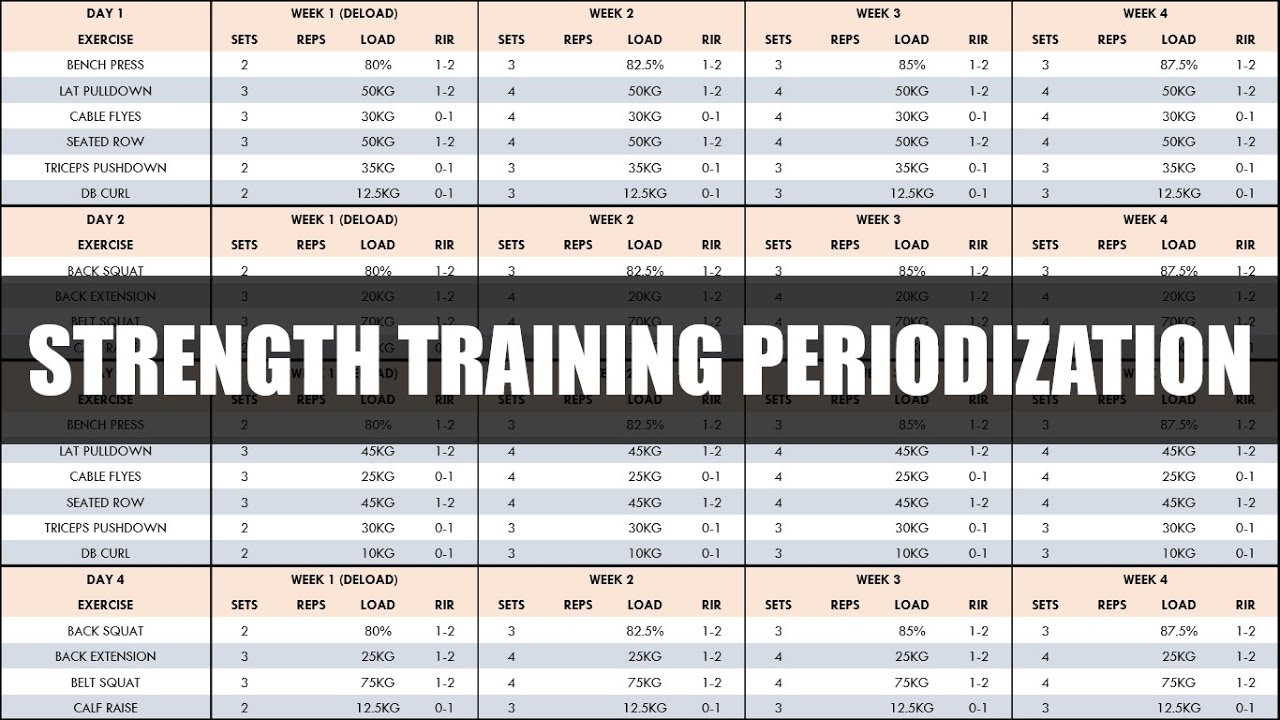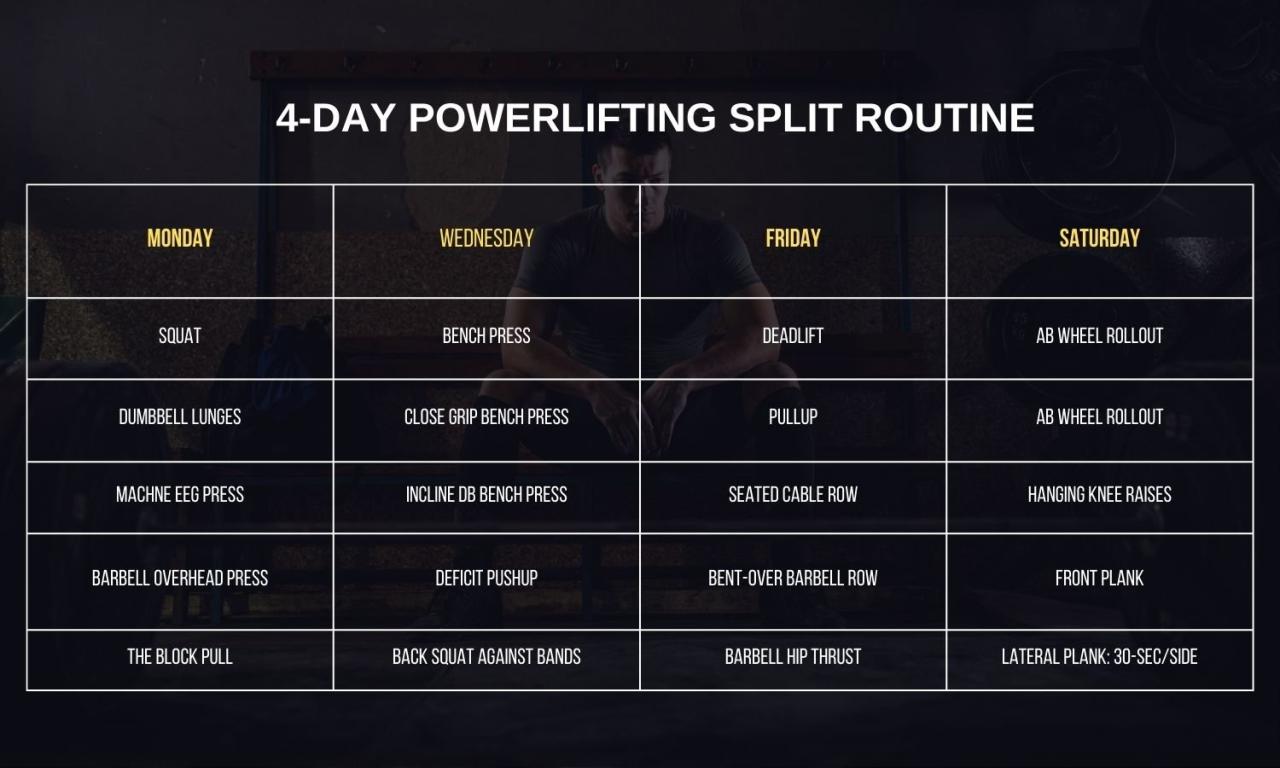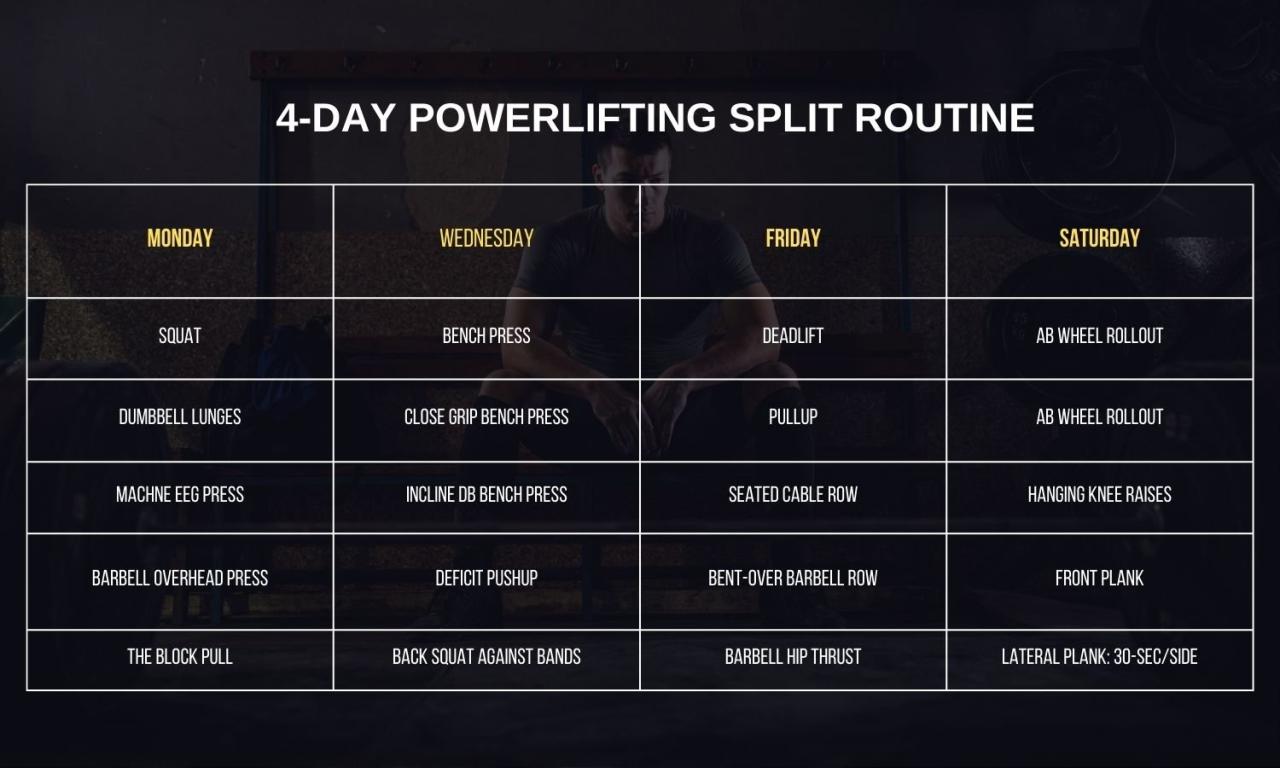Advanced Weight Training Program for Experienced Lifters to Increase Strength: Forget those wimpy beginner routines! This isn’t your grandma’s aerobics class. We’re diving headfirst into a world of iron, sweat, and serious strength gains. Prepare to unleash your inner beast and conquer new personal bests. We’ll cover everything from meticulously crafted periodization plans to advanced training techniques that’ll leave your muscles begging for mercy (in a good way, of course).
This program is designed for seasoned lifters who are ready to push their limits. We’ll explore the nuances of progressive overload, dissect the best exercises for maximizing strength, and delve into the crucial role of nutrition and recovery. Think of it as your personal training manual, written by someone who understands the pain (and the glorious gains) of serious lifting.
Program Design Principles for Experienced Lifters
So, you’re a seasoned lifter, huh? You’ve conquered the newbie gains, and now you’re staring down the barrel of serious strength. Welcome to the advanced leagues, where the gains are harder-won, but oh-so-sweet. This program focuses on maximizing your potential, but remember, consistency and smart training are your best allies. Don’t expect miracles overnight; this is a marathon, not a sprint.
Sample 12-Week Advanced Strength Training Program
This program utilizes a classic upper/lower split, focusing on compound movements to maximize strength gains. Remember to adjust weights based on your individual capabilities. Don’t be a hero; prioritize proper form over ego-lifting. Listen to your body and take rest days when needed. This isn’t a race to the bottom; it’s a journey to the top.
| Day | Focus | Exercises | Sets/Reps |
|---|---|---|---|
| Monday | Upper Body | Bench Press: 3 sets of 3-5 reps; Incline Dumbbell Press: 3 sets of 6-8 reps; Overhead Press: 3 sets of 5-7 reps; Barbell Rows: 3 sets of 6-8 reps; Bicep Curls: 3 sets of 8-12 reps; Triceps Extensions: 3 sets of 8-12 reps | Vary weight to maintain intensity |
| Tuesday | Lower Body | Squats: 3 sets of 3-5 reps; Romanian Deadlifts: 3 sets of 6-8 reps; Leg Press: 3 sets of 8-12 reps; Leg Extensions: 3 sets of 10-15 reps; Hamstring Curls: 3 sets of 10-15 reps; Calf Raises: 3 sets of 15-20 reps | Vary weight to maintain intensity |
| Wednesday | Rest or Active Recovery | Light cardio, stretching, foam rolling | As needed |
| Thursday | Upper Body | Bench Press variations (close-grip, wide-grip): 3 sets of 3-5 reps each; Overhead Press variations (Arnold Press, push press): 3 sets of 6-8 reps each; Pull-ups/Lat Pulldowns: 3 sets of as many reps as possible (AMRAP); Face pulls: 3 sets of 15-20 reps | Vary weight to maintain intensity |
| Friday | Lower Body | Deadlifts: 1-3 sets of 1-5 reps; Front Squats: 3 sets of 5-7 reps; Lunges: 3 sets of 8-12 reps per leg; Glute-Ham Raises (GHR): 3 sets of AMRAP; Calf Raises: 3 sets of 15-20 reps | Vary weight to maintain intensity |
| Saturday & Sunday | Rest or Active Recovery | Light cardio, stretching, foam rolling | As needed |
Periodization in Advanced Strength Training
Periodization is the strategic manipulation of training variables (volume, intensity, frequency) over time to optimize strength gains and prevent overtraining. Think of it as a carefully orchestrated symphony of iron, where each movement plays its part in the grand scheme of muscle growth. Ignoring periodization is like trying to build a house without a blueprint – chaotic and ultimately ineffective.
Different periodization models exist, including linear periodization (gradually increasing intensity over time) and non-linear periodization (varying intensity and volume within a microcycle). A well-designed program will incorporate these principles.
Progressive Overload for Experienced Lifters
Progressive overload is the cornerstone of strength gains, but for experienced lifters, it requires a more nuanced approach. Simply adding weight each week isn’t enough. Methods include increasing weight, reps, sets, or decreasing rest periods. You might also try incorporating advanced training techniques like drop sets, rest-pause sets, or forced reps, but use these judiciously to avoid injury.
Remember, small, consistent improvements are better than sporadic bursts of intensity followed by burnout.
Linear vs. Non-Linear Periodization
Linear periodization follows a predictable path of increasing intensity and decreasing volume over time. It’s simple to understand and implement, but can become monotonous and may lead to plateaus. Non-linear periodization, on the other hand, varies intensity and volume within shorter cycles (microcycles), allowing for more frequent variations and potentially preventing stagnation. The best approach depends on individual needs and preferences.
Both have their merits and drawbacks, and neither is universally superior.
Exercise Selection and Variation
Let’s face it, lifting weights isn’t just about grunting and groaning; it’s a strategic dance of iron and muscle. To truly maximize strength gains as an experienced lifter, you need a well-chosen exercise arsenal and the wisdom to wield it effectively. This section will delve into the art of exercise selection and variation, ensuring your training remains challenging, productive, and – dare we say – fun.
Five Crucial Compound Exercises for Overall Strength
Compound exercises are the heavy hitters of strength training – they work multiple muscle groups simultaneously, leading to significant strength gains and overall body development. Ignoring them is like trying to build a house with only toothpicks. Here are five cornerstones of any advanced strength program:
- Squat: The king of lower body exercises. Proper form involves a hip-width stance, toes slightly outward, chest up, back straight (think neutral spine!), and a controlled descent until your thighs are parallel to the ground (or lower, if mobility allows). Drive back up explosively, maintaining a stable core. Avoid rounding your back – it’s a recipe for disaster.
- Deadlift: The ultimate full-body strength builder. Start with your feet hip-width apart, shins close to the bar. Grip the bar with an overhand or mixed grip (one overhand, one underhand), keeping your back straight. Hinge at your hips, maintaining a neutral spine, and pull the bar upwards, extending your hips and knees simultaneously. Lower the bar with the same controlled movement.
- Bench Press: The classic upper body push. Lie on a bench with your feet flat on the floor. Grip the bar slightly wider than shoulder-width, lower it to your chest (touching lightly), and press it back up explosively. Keep your elbows slightly tucked and avoid letting your shoulder blades leave the bench.
- Overhead Press: A fantastic shoulder and upper body strength builder. Stand with feet shoulder-width apart, holding the bar at shoulder height. Press the bar straight overhead, keeping your core engaged and elbows slightly tucked. Lower the bar with control.
- Barbell Rows: Essential for back development and overall strength. Hinge at the hips, maintaining a straight back, and grip the bar with an overhand grip. Pull the bar towards your abdomen, squeezing your shoulder blades together. Lower the bar slowly and with control.
Advanced Variations of Core Compound Exercises
Once you’ve mastered the basics, it’s time to spice things up. Advanced variations challenge your muscles in new ways, promoting continued growth and strength gains. But remember, increased challenge means increased risk of injury. Proceed with caution and proper form.
- Bench Press Variations:
- Incline Bench Press: Targets the upper chest. Benefits: increased upper chest activation. Risks: increased shoulder stress if form is compromised.
- Decline Bench Press: Emphasizes the lower chest. Benefits: enhanced lower chest development. Risks: increased stress on the lower back and shoulders if proper form is not maintained.
- Close-Grip Bench Press: Focuses on the triceps. Benefits: increased triceps hypertrophy. Risks: increased stress on the wrists and elbows if technique is not perfect.
- Squat Variations:
- Front Squat: Places more emphasis on the quads. Benefits: improved quadriceps development and balance. Risks: increased stress on the shoulders and wrists if the bar placement isn’t correct.
- Pause Squat: Adds a pause at the bottom of the squat. Benefits: increased time under tension, improved strength at the sticking point. Risks: Increased stress on the knees and lower back.
- Bulgarian Split Squat: Unilateral exercise emphasizing balance and leg strength. Benefits: Improved balance and unilateral strength. Risks: increased risk of injury if proper form is not followed.
- Deadlift Variations:
- Sumo Deadlift: Wider stance, emphasizing the quads and glutes. Benefits: altered muscle activation pattern, potential for greater weight. Risks: increased stress on the groin and inner thighs.
- Romanian Deadlift (RDL): Focuses on hamstring and glute development. Benefits: improved hamstring and glute strength. Risks: increased risk of lower back injury if form is poor.
- Deficit Deadlift: Lifting from a lower platform. Benefits: Increased range of motion, improved strength throughout the lift. Risks: increased stress on the lower back and hamstrings.
The Importance of Accessory Exercises
Think of accessory exercises as the supporting cast in your strength-building movie. While compound exercises lay the foundation, accessory exercises fine-tune muscle development, address weaknesses, and prevent imbalances. They’re crucial for maximizing strength gains and minimizing injury risk.
Effective Accessory Exercises for Various Muscle Groups
- Chest: Cable flyes, dumbbell bench press, push-ups (various hand placements).
- Back: Pull-ups (various grips), lat pulldowns, face pulls, seated cable rows.
- Legs: Leg extensions, hamstring curls, calf raises, glute bridges.
- Shoulders: Lateral raises, front raises, reverse flyes, face pulls.
- Arms: Bicep curls (various variations), triceps extensions (various variations), hammer curls.
Exercises Targeting Specific Muscle Groups
Here’s a more detailed breakdown of effective exercises for each muscle group, including variations:
- Chest: Barbell bench press (incline, flat, decline), dumbbell bench press (incline, flat, decline), cable flyes (various angles), push-ups (various hand placements).
- Back: Barbell rows (various grips), pull-ups (various grips), lat pulldowns (various grips), seated cable rows, T-bar rows, face pulls.
- Legs: Barbell squats (high-bar, low-bar, front), leg press, leg extensions, hamstring curls, Romanian deadlifts, good mornings, lunges (forward, reverse, lateral), Bulgarian split squats, calf raises.
- Shoulders: Overhead press (barbell, dumbbell), lateral raises (dumbbell, cable), front raises (dumbbell, cable), reverse flyes (dumbbell, cable), Arnold press.
- Arms: Bicep curls (barbell, dumbbell, hammer, concentration), triceps extensions (overhead, skullcrushers, close-grip bench press), triceps pushdowns (rope, straight bar, V-bar).
Power Clean: A Visual Description of Proper Form
Imagine a powerful, explosive movement. The lifter starts with the barbell resting on the floor, feet hip-width apart. They bend down, maintaining a straight back, grabbing the bar with an overhand or mixed grip. The initial pull is from the legs, driving the bar upwards explosively. As the bar passes the knees, the lifter quickly pulls themselves under the bar, using a high-pull action to get the bar to shoulder height.
The bar is then caught in a front rack position, elbows high and pointing forward. The lifter then stands upright with the bar held at shoulder height, demonstrating controlled power. Key muscle groups involved include the quads, hamstrings, glutes, back, shoulders, and traps. Potential points of failure include rounding the back during the initial pull, improper bar path, and a lack of explosive power.
Failing to maintain a stable core throughout the lift can also lead to injury.
Nutrition and Recovery Strategies: Advanced Weight Training Program For Experienced Lifters To Increase Strength

Fueling your body like a finely-tuned sports car is crucial for maximizing strength gains. Forget the “bro science” – we’re talking about a strategic approach to nutrition and recovery that will leave your muscles screaming “Thank you!” This isn’t just about eating more; it’s about eating – smart*.
Macronutrient Timing for Optimal Muscle Growth and Recovery
Proper macronutrient timing plays a significant role in muscle protein synthesis and recovery. Consuming carbohydrates and protein before a workout provides energy and spares muscle glycogen. Post-workout, a rapid intake of protein and carbohydrates replenishes glycogen stores and initiates muscle repair. A pre-workout snack might include a banana with a scoop of whey protein, while a post-workout meal could consist of grilled chicken breast with brown rice and steamed broccoli.
Timing isn’t everything, however; consistent, overall macronutrient intake throughout the day is paramount.
The Importance of Sleep, Stress Management, and Hydration
Think of sleep, stress management, and hydration as the unsung heroes of your strength-building journey. Adequate sleep (7-9 hours per night) allows your body to repair and rebuild muscle tissue. Chronic stress elevates cortisol levels, hindering muscle growth and recovery. Hydration is essential for nutrient transport, temperature regulation, and overall bodily function. Dehydration can significantly impact performance and recovery.
Implementing stress-reduction techniques like yoga or meditation, prioritizing sleep hygiene, and carrying a reusable water bottle are simple yet powerful strategies.
Ready to ditch the kiddie weights and unleash your inner beast? Advanced weight training for experienced lifters means pushing past plateaus, and that requires a serious commitment to mastering the fundamentals. To really dial in your gains, check out this awesome resource on muscular strength exercises – it’s packed with tips and tricks to help you build a truly monstrous program.
Then, get back to those heavy lifts and conquer new personal bests!
Sample Meal Plan for an Experienced Strength Lifter, Advanced weight training program for experienced lifters to increase strength
This sample meal plan provides approximately 3000 calories with a macronutrient ratio of 40% carbohydrates, 35% protein, and 25% fat. Adjust calorie and macronutrient intake based on individual needs and goals.
| Meal | Description | Calories (approx.) | Macronutrients (approx.) |
|---|---|---|---|
| Breakfast (7:00 AM) | Oatmeal with berries, nuts, and whey protein | 500 | 50g carbs, 30g protein, 15g fat |
| Mid-Morning Snack (10:00 AM) | Greek yogurt with fruit | 200 | 20g carbs, 20g protein, 5g fat |
| Lunch (1:00 PM) | Chicken breast salad with quinoa and avocado | 600 | 60g carbs, 40g protein, 20g fat |
| Pre-Workout Snack (4:00 PM) | Banana with peanut butter | 250 | 30g carbs, 10g protein, 10g fat |
| Post-Workout Meal (6:00 PM) | Lean steak with sweet potato and asparagus | 750 | 70g carbs, 50g protein, 25g fat |
| Dinner (9:00 PM) | Salmon with brown rice and broccoli | 700 | 60g carbs, 40g protein, 30g fat |
Protein Sources for Muscle Growth and Recovery
Various protein sources offer unique benefits. Whey protein is rapidly digested, ideal for post-workout consumption. Casein protein digests slowly, providing a sustained release of amino acids. Lean meats, poultry, fish, eggs, and legumes are excellent whole-food sources of protein. While all provide essential amino acids, the rate of digestion and bioavailability can influence their effectiveness.
Supplements to Support Strength Gains and Recovery
Supplements can play a supporting role, but they are not a replacement for proper nutrition and training.
- Creatine Monohydrate: Enhances strength and power output. Caution: May cause water retention.
- Whey Protein: Convenient source of protein for muscle growth and repair. Caution: Choose high-quality, unflavored options to avoid added sugars.
- Caffeine: Improves focus and performance. Caution: Excessive consumption can lead to anxiety and insomnia.
- Beta-Alanine: May improve muscle endurance and reduce fatigue. Caution: May cause paresthesia (tingling).
Monitoring Progress and Adjustments

So, you’ve embarked on this advanced weight training odyssey, a journey to forge yourself into a stronger, more resilient version of your awesome self. But how do you know if your Herculean efforts are actually paying off? This isn’t some mystical quest; it’s a data-driven expedition. Tracking your progress isn’t just about numbers; it’s about understanding your body’s response and adapting your strategy accordingly.
Progress Tracking Methods
Tracking progress in strength training isn’t about simply lifting heavier weights. It’s about observing trends, identifying patterns and making informed decisions. Several methods can help you achieve this. The most common is to track your 1-rep max (1RM) – the maximum weight you can lift for a single repetition with proper form. This gives you a clear benchmark of your overall strength gains.
However, tracking sets and reps across multiple workouts provides a more nuanced picture, revealing improvements in strength endurance and work capacity. Imagine it like this: your 1RM is the peak of a mountain, but tracking sets and reps reveals the entire climb, showing how your stamina is improving. You might find that while your 1RM hasn’t budged, your ability to complete multiple sets with heavier weight has increased significantly.
Addressing Strength Training Plateaus
Ah, the dreaded plateau. That frustrating period where your gains grind to a halt, leaving you feeling like you’re pushing a boulder uphill with a toothpick. Plateaus are a normal part of the process, often signaling that your body has adapted to your current training stimulus. To break through, consider these strategies: First, try deloading – reducing training volume and intensity for a short period to allow your body to recover and rebuild.
Think of it as a strategic retreat to prepare for a more powerful advance. Another tactic is to change your training variables – increase the weight, reps, sets, or even switch to different exercises. Finally, review your nutrition and sleep; these are often overlooked factors that significantly influence your body’s ability to recover and grow stronger. Remember, even the mightiest warriors need rest and sustenance!
Program Adjustment Based on Individual Response
Your training program isn’t a rigid set of rules etched in stone; it’s a flexible roadmap. Individual responses vary widely. What works wonders for one lifter might be utterly ineffective for another. Regularly evaluate your progress. If you’re consistently exceeding your planned reps and sets, it’s time to increase the weight or difficulty.
If you’re struggling, it might be time to decrease the weight, reduce the volume, or focus on improving your form. Listen to your body – pain is a signal, not a badge of honor. A little soreness is expected, but sharp, persistent pain warrants immediate attention and modification of the exercise.
Exercise Modification for Individual Limitations
Injuries or limitations don’t have to derail your training entirely. Smart modifications can allow you to continue progressing while protecting your body. For example, if you have a shoulder injury, you might substitute barbell presses with dumbbell presses, allowing for a greater range of motion and less stress on the shoulder joint. Or, if back pain is an issue, you might replace deadlifts with Romanian deadlifts (RDLs), which emphasize the hamstrings and glutes more and place less stress on the lower back.
Creativity is key! There are countless ways to adapt exercises to accommodate individual needs, always prioritizing safety and proper form.
Weekly Progress Tracking Template
| Week | Exercise | Weight (kg) | Reps |
|---|---|---|---|
| 1 | Squat | 80 | 8 |
| 1 | Bench Press | 60 | 10 |
| 1 | Deadlift | 100 | 5 |
| 2 | Squat | 82.5 | 7 |
| 2 | Bench Press | 62.5 | 9 |
| 2 | Deadlift | 105 | 4 |
Advanced Training Techniques
Let’s ditch the kiddie pool and dive into the deep end of strength training. We’re talking advanced techniques here, the kind that’ll make your muscles scream with joy (or maybe just scream). These aren’t for the faint of heart – or the newly initiated – but for those seasoned veterans ready to push their limits and sculpt physiques worthy of mythical legends.
Drop Sets, Supersets, and Rest-Pause Sets
These techniques are like the secret weapons in a strength trainer’s arsenal, designed to obliterate plateaus and spark new muscle growth. Drop sets involve performing a set to failure, then immediately reducing the weight and continuing until failure again. This process can be repeated multiple times. Supersets pair two exercises targeting opposing muscle groups (like biceps and triceps) back-to-back with minimal rest, maximizing time under tension and metabolic stress.
Rest-pause sets involve performing a set to failure, resting briefly (around 10-15 seconds), and then continuing the set until failure again. This allows you to push past your initial perceived limits. The key is controlled execution to avoid injury.
Training Intensities: High vs. Moderate
High-intensity training (HIT), characterized by very heavy weights and low reps (1-5), is the domain of strength athletes aiming for maximal strength gains. It’s brutal, demanding, and requires meticulous planning and recovery. Moderate intensity training, using weight loads that allow for 6-12 repetitions, focuses on hypertrophy (muscle growth) and overall strength development. Think of HIT as a sledgehammer, focused power, and moderate intensity as a chisel, shaping and refining.
The choice depends entirely on your specific goals and current training status. A seasoned lifter might incorporate both strategically throughout their program. For example, a powerlifter might prioritize HIT for their main lifts while using moderate intensity for accessory exercises.
Rep Ranges and Training Goals
Different rep ranges target different physiological adaptations. The 1-5 rep range, as mentioned, is king for maximal strength. The 6-12 rep range is the sweet spot for muscle hypertrophy. Beyond 12 reps, the focus shifts towards muscular endurance and potentially metabolic conditioning. A well-designed program will incorporate all these rep ranges strategically to address multiple training goals.
Consider a program that incorporates heavy low-rep sets for squats followed by higher-rep sets of leg extensions to target both strength and hypertrophy in the legs.
Training Splits: Upper/Lower, Push/Pull/Legs
Training splits are all about optimizing muscle recovery and growth by strategically scheduling workouts. The upper/lower split targets the upper body one day and the lower body the next, allowing for sufficient recovery time for each muscle group. The push/pull/legs split divides exercises into pushing movements (chest, shoulders, triceps), pulling movements (back, biceps), and leg exercises, offering a different approach to muscle group prioritization and recovery.
The best split depends on individual preferences, training experience, and recovery capacity. An experienced lifter might find a push/pull-legs split more effective due to its ability to allow for more frequent training of specific muscle groups.
Advanced Training Techniques: Benefits and Drawbacks
| Technique | Benefits | Drawbacks | Example |
|---|---|---|---|
| Drop Sets | Increased muscle hypertrophy, improved muscular endurance, mental toughness | Increased risk of injury if not performed correctly, significant fatigue | Performing barbell bench presses to failure, then immediately reducing the weight by 20% and continuing to failure, repeating this process once or twice more. |
| Supersets | Increased time under tension, enhanced metabolic stress, time efficiency | Increased fatigue, potential for compromised form if not properly managed | Performing barbell rows followed immediately by lat pulldowns, with minimal rest between sets. |
| Rest-Pause Sets | Ability to push past perceived limits, increased strength and hypertrophy | Requires significant mental fortitude, risk of injury if not properly managed | Performing squats to failure, resting for 10-15 seconds, then continuing the set until failure again. |
| High-Intensity Training (HIT) | Significant strength gains, efficient use of training time | High risk of injury, requires extensive recovery, not suitable for all individuals | Performing 3 sets of 5 reps of squats with a weight that allows for only 5 reps with good form. |
| Moderate-Intensity Training | Muscle hypertrophy, improved strength, less risk of injury compared to HIT | Slower strength gains compared to HIT, requires consistent training over a longer period | Performing 3 sets of 8-12 reps of bench press with a weight that allows for good form throughout the set. |
Wrap-Up

So, there you have it – a roadmap to unlocking previously unimaginable levels of strength. Remember, consistency is key. Don’t expect miracles overnight, but with dedication, the right plan, and maybe a little bit of stubbornness, you’ll be amazed at what you can achieve. Now go forth and conquer those weights! And remember to stretch – seriously, you’ll thank me later.
